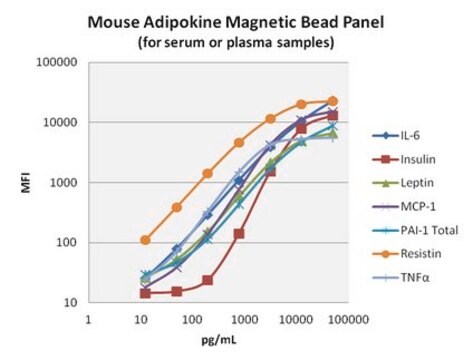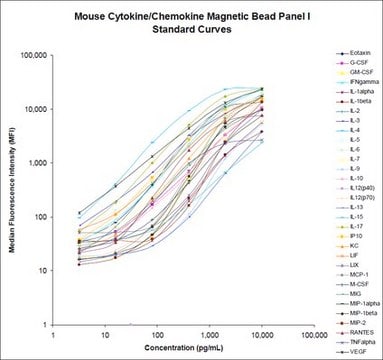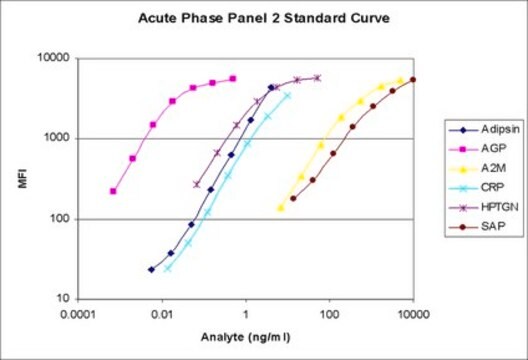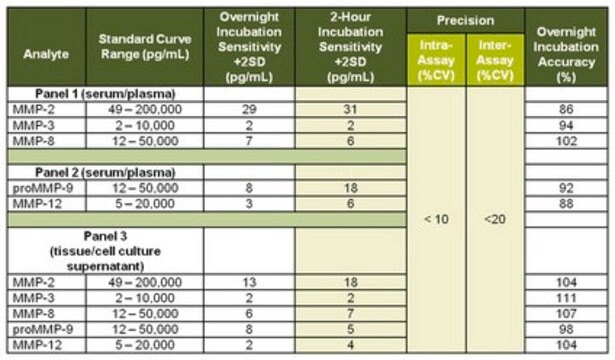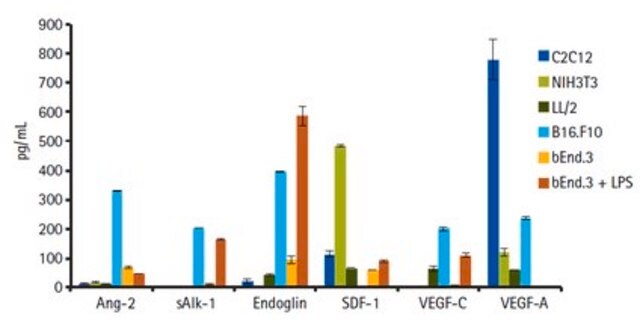MMYOMAG-74K
MILLIPLEX® Mouse Myokine Magnetic Bead Panel
Inflammation/Immunology Bead-Based Multiplex Assays using the Luminex technology enable the simultaneous analysis of multiple myokine and cytokine biomarkers in mouse serum and plasma samples.
About This Item
Recommended Products
Quality Level
species reactivity
mouse
manufacturer/tradename
Milliplex®
assay range
accuracy: 3-40,000 pg/mL
(Osteocrin)
standard curve range: 0.6-9,000 pg/mL
(BDNF)
standard curve range: 128-2,000,000 pg/mL
(Osteonectin (SPARC))
standard curve range: 16-250,000 pg/mL
(Oncostatin M)
standard curve range: 22-350,000 pg/mL
(EPO)
standard curve range: 256-4,000,000 pg/mL
(Myostatin)
standard curve range: 26-400,000 pg/mL
(26Irisin)
standard curve range: 3-40,000 pg/mL
(LIF)
standard curve range: 3-40,000 pg/mL
(Osteocrin/Musclin (OSTN))
standard curve range: 48-750,000 pg/mL
(IL-15)
standard curve range: 5-75,000 pg/mL
(FGF21)
standard curve range: 9-140,000 pg/mL
(IL-6)
inter-assay cv: <15%
intra-assay cv: <10%
technique(s)
multiplexing: suitable
detection method
fluorometric (Luminex xMAP)
shipped in
ambient
General description
MILLIPLEX® Mouse Myokine Panel is a 12-plex kit to be used for the simultaneous quantification of any or all of the following analytes in serum, plasma, and tissue culture samples: Brain-derived Neurotrophic Factor (BDNF), Erythropoeitin (EPO)*, Fibroblast Growth Factor 21 (FGF21), Follistatin-Like Protein 1 (FSTL-1), IL-6, IL-15, Irisin, Leukemia Inhibitory Factor (LIF), Myostatin (MSTN / GDF8), Oncostatin M (OSM), Osteocrin/Musclin (OSTN), Osteonectin (SPARC).
*Only available for cells culture samples.
This kit uses a 96-well format, contains a lyophilized standard cocktail, two internal assay quality controls and can measure up to 38 samples in duplicate.
The Luminex® xMAP® platform uses a magnetic bead immunoassay format for ideal speed and sensitivity to quantitate multiple analytes simultaneously, dramatically improving productivity while conserving valuable sample volume.
Panel Type: Metabolism
Application
- Analytes: Brain Derived Neurotrophic Factor (BDNF), Erythropoietin (EPO), Fibroblast Growth Factor 21 (FGF-21), Follistatin-like Protein 1 (FSTL1), IL-6, IL-15, Irisin, Leukemia Inhibitory Factor (LIF), Myostatin (MSTN/GDF8), Oncostatin M (OSM), Osteocrin (OSTN/Musclin), Osteonectin (SPARC)
- NOTES: BDNF - Substantial amounts of BDNF are stored in circulating platelets and subsequently released upon platelet activation. Therefore, platelet-poor plasma is critical to ensure accurate measurement of circulating levels of BDNF. OSM - While OSM is barely detectable in the serum/plasma of healthy subjects, a slight increase can be observed in certain disease states. Higher measurements in cell culture samples have also been reported. Erythropoeitin (EPO) is for tissue culture samples only and cannot be combined with other analytes in this panel when measuring serum or plasma.
- Recommended Sample Type: Mouse serum, plasma, or cell/tissue culture supernatants or lysates
- Recommended Sample Dilution: 25 μL per well of 1:2 diluted serum or plasma; cell/tissue culture samples may require dilution in an appropriate control medium.
- Assay Run Time: For greater sensitivity an overnight incubation is recommended, (16-18 hours) at 2-8°C. Alternatively, incubate for 2 hours at room temperature (20-25°C).
- Research Category: Metabolism
- Research Subcategory: Obesity, Metabolic Disorders, Inflammation
Features and Benefits
Other Notes
Legal Information
Signal Word
Danger
Hazard Statements
Precautionary Statements
Hazard Classifications
Acute Tox. 4 Dermal - Acute Tox. 4 Inhalation - Acute Tox. 4 Oral - Aquatic Chronic 2 - Eye Dam. 1 - Skin Sens. 1 - STOT RE 2
Target Organs
Respiratory Tract
WGK
WGK 3
Certificates of Analysis (COA)
Search for Certificates of Analysis (COA) by entering the products Lot/Batch Number. Lot and Batch Numbers can be found on a product’s label following the words ‘Lot’ or ‘Batch’.
Already Own This Product?
Find documentation for the products that you have recently purchased in the Document Library.
Related Content
Myokine analysis with multiplex immunoassays, such as the MILLIPLEX® Human Myokine Panel, allow researchers to simultaneously measure multiple muscle-secreted factors, providing more insights into related diseases.
Our team of scientists has experience in all areas of research including Life Science, Material Science, Chemical Synthesis, Chromatography, Analytical and many others.
Contact Technical Service